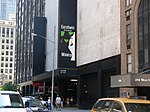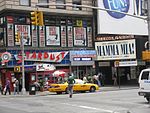Mark Hellinger Theatre

The Mark Hellinger Theatre (formerly the 51st Street Theatre and the Hollywood Theatre) is a church building at 237 West 51st Street in the Midtown Manhattan neighborhood of New York City, which formerly served as a cinema and a Broadway theatre. Opened in 1930, the Hellinger Theatre is named after journalist Mark Hellinger and was developed by the Warner Bros. as a movie palace. It was designed by Thomas W. Lamb with a modern facade and a Baroque interior. It has 1,605 seats across two levels and has been a house of worship for the Times Square Church since 1989. Both the exterior and interior of the theater are New York City landmarks. The facade on 51st Street is designed in a modern 1930s style and is constructed with golden and brown bricks. The stage house to the west and the auditorium at the center are designed as one unit, with a cornice above the auditorium. The eastern section, containing the building's current main entrance, includes statues flanking the doors, as well as an overhanging marquee. The 51st Street facade was originally a side entrance; the main entrance was originally at 1655 Broadway but was closed in the 1950s. In contrast to the exterior, the theater has a Baroque interior. Its rotunda lobby contains eight fluted columns, a balcony, and a domed ceiling with several murals; a basement lounge exists under the lobby. The auditorium has a coved ceiling with murals, as well as boxes and a deep stage. For the first two decades of the Hellinger Theatre's existence, it largely served as a cinema under the Hollywood Theatre name. Vaudeville was presented in 1932, and some legitimate productions were shown intermittently from 1934 to 1942. The theater was briefly known as the 51st Street Theatre in 1936 and 1941 and as the Warner Theatre from 1947 to 1948. Anthony Brady Farrell bought the theater and renamed it after Hellinger, reopening it as a legitimate theater in 1949. The theater was subsequently acquired by the Stahl family in 1957 and the Nederlander Organization in 1976. The Hellinger hosted some hits from the 1950s to the 1970s, including My Fair Lady and Timbuktu!, but its later productions were mostly flops. By 1989, a lack of Broadway productions prompted the Nederlanders to lease the theater to the Times Square Church, which bought the building two years later.
Excerpt from the Wikipedia article Mark Hellinger Theatre (License: CC BY-SA 3.0, Authors, Images).Mark Hellinger Theatre
West 51st Street, New York Manhattan
Geographical coordinates (GPS) Address External links Nearby Places Show on map
Geographical coordinates (GPS)
| Latitude | Longitude |
|---|---|
| N 40.7625 ° | E -73.984166666667 ° |
Address
Times Square Church
West 51st Street 237
10019 New York, Manhattan
New York, United States
Open on Google Maps









